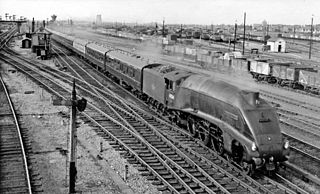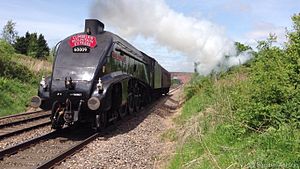
The LNER Class A4 is a class of streamlined 4-6-2 steam locomotive designed by Nigel Gresley for the London and North Eastern Railway in 1935. Their streamlined design gave them high-speed capability as well as making them instantly recognisable, and one of the class, 4468 Mallard, holds the record as the world's fastest steam locomotive. Thirty-five of the class were built to haul express passenger trains on the East Coast Main Line route from London Kings Cross via York to Newcastle, and later via Newcastle to Edinburgh, Scotland. They remained in service on the East Coast Main Line until the early 1960s when they were replaced by Deltic diesel locomotives; they themselves proving to be worthy successors to the A4s. Several A4s saw out their remaining days until 1966 in Scotland, particularly on the Aberdeen – Glasgow express trains, for which they were used to improve the timing from 3.5 to 3 hours.

LNER Class A4 4468 Mallard is a 4-6-2 ("Pacific") steam locomotive built in 1938 for operation on the London and North Eastern Railway (LNER) at Doncaster Works to a design of Nigel Gresley. Its streamlined, wind tunnel tested design allowed it to haul long distance express passenger services at high speeds. On 3 July 1938, Mallard broke the world speed record for steam locomotives at 126 mph (203 km/h), which still stands today.

No. 4472 Flying Scotsman is a LNER Class A3 4-6-2 "Pacific" steam locomotive built in 1923 for the London and North Eastern Railway (LNER) at Doncaster Works to a design of Nigel Gresley. It was employed on long-distance express passenger trains on the East Coast Main Line by LNER and its successors, British Railways' Eastern and North Eastern Regions, notably on The Flying Scotsman service between London King's Cross and Edinburgh Waverley after which it was named.

60008 Dwight D Eisenhower is an LNER Class A4 steam locomotive named after Dwight D. Eisenhower, the United States General of the Army.

4464Bittern is a London and North Eastern Railway (LNER) Class A4 steam locomotive. Built for the LNER and completed on 18 December 1937 at Doncaster Works as works number 1866, it received number 4464. After that it was renumbered 19 on 16 August 1946 under the LNER 1946 renumbering scheme, and finally 60019 by British Railways on 10 October 1948, after nationalisation. Of the 35 strong class, it is one of six to survive into preservation but it is one of only two currently scheduled to be certified for mainline use.

60007 Sir Nigel Gresley is an LNER Class A4 4-6-2 ("Pacific") steam locomotive built at Doncaster Works in 1937 to a design of Sir Nigel Gresley for operation on the London and North Eastern Railway (LNER). The locomotive holds the post-war speed record for steam locomotives on British Railways. The locomotive was withdrawn from service in 1966 and purchased for preservation the same year; it is one of six A4s to be preserved.

4489 Dominion of Canada is an LNER Class A4 steam locomotive. It is a 4-6-2 locomotive built to the same design by Sir Nigel Gresley as the more famous Mallard. There were 35 A4 locomotives built in total. Originally numbered 4489, it was renumbered 10 on 10 May 1946, under the LNER 1946 renumbering scheme of Edward Thompson and, after nationalisation in 1948, British Railways added 60000 to its number so it became 60010 on 27 October 1948. It was renumbered back to 4489 following a cosmetic restoration at the National Railway Museum in York during late 2012 and early 2013.

The London and North Eastern Railway (LNER) Thompson Class B1 is a class of steam locomotive designed by Edward Thompson for medium mixed traffic work.

The London and North Eastern Railway Gresley Classes A1 and A3 locomotives represented two distinct stages in the history of the British 4-6-2 "Pacific" steam locomotives designed by Nigel Gresley. They were designed for main line passenger services and later express passenger services, initially on the Great Northern Railway (GNR), a constituent company of the London and North Eastern Railway after the amalgamation of 1923, for which they became a standard design. The change in class designation to A3 reflected the fitting to the same chassis of a higher pressure boiler with a greater superheating surface and a small reduction in cylinder diameter, leading to an increase in locomotive weight. Eventually all of the A1 locomotives were rebuilt, most to A3 specifications, but no. 4470 was completely rebuilt as Class A1/1.

The Gresley conjugated valve gear is a valve gear for steam locomotives designed by Sir Nigel Gresley, chief mechanical engineer of the LNER, assisted by Harold Holcroft. It enables a three-cylinder locomotive to operate with only the two sets of valve gear for the outside cylinders, and derives the valve motion for the inside cylinder from them by means of levers. The gear is sometimes known as the Gresley-Holcroft gear, acknowledging Holcroft's major contributions to its development.

The London and North Eastern Railway (LNER) Class K4 is a class of 2-6-0 steam locomotives designed by Nigel Gresley for the steep grades of the West Highland Line.

LNER Peppercorn Class A1 No. 60163 Tornado is a 4-6-2 steam locomotive completed in 2008 to an original design by Arthur Peppercorn. It is the first new build British mainline steam locomotive since 1960, and the only Peppercorn Class A1 in existence after the original batch were scrapped. In 2017, Tornado became the first steam locomotive to officially reach 100 mph (160 km/h) on British tracks in over 50 years.

The LNER W1 No. 10000 was an experimental steam locomotive fitted with a high pressure water-tube boiler. Nigel Gresley was impressed by the results of using high-pressure steam in marine applications and so in 1924 he approached Harold Yarrow of shipyard and boilermakers Yarrow & Company of Glasgow to design a suitable boiler for a railway locomotive, based on Yarrow's design.

The GER Classes S46, D56 and H88 were three classes of similar 4-4-0 steam locomotive designed by James Holden and A. J. Hill (H88) for the Great Eastern Railway.

The London and North Eastern Railway Class P2 was a class of 2-8-2 steam locomotives designed by Sir Nigel Gresley for working heavy express trains over the harsh Edinburgh to Aberdeen Line. As they were to serve on Scottish expresses, they were given famous names from Scottish lore.

LNER Class A4 4902 Seagull was one of 35 Doncaster built LNER Class A4 Gresley Pacific steam locomotives.

LNER Class A4 60034 Lord Faringdon was one of 35 Doncaster built Class A4 Gresley Pacific steam locomotives.

The streamlined East Anglian service of the London and North Eastern Railway was introduced on 27 September 1937, soon after the Coronation and the West Riding Limited, but differed from those – and from the Silver Jubilee of 1935 – in several respects. It did not use new Class A4 4-6-2 locomotives but instead existing Class B17 4-6-0s were given a streamlined casing; although new carriages were built, these were neither articulated nor streamlined; there was no special livery; it ran at speeds not much greater than those achieved by existing expresses on the Norwich line; and there was no supplementary fare.

LNER 3442 The Great Marquess is a member of the London and North Eastern Railway (LNER) Class K4 designed by Nigel Gresley for the steep grades of the West Highland Line. It was renumbered 1994 in the LNER's 1946 renumbering scheme, and then renumbered 61994 by British railways after the 1948 nationalisation of Britain's railways.

LNER Class A3 2750 Papyrus was a 4-6-2 "Pacific" steam locomotive built for the London and North Eastern Railway (LNER) at Doncaster Works to a design of Nigel Gresley, entering service in March 1929. Primarily used to haul express passenger trains on the East Coast Main Line by LNER and its successor, British Railways, it is notable for achieving what was at the time a world record-breaking speed for a steam locomotive of 108 mph on 5 March, 1935. A fictionalized account based on the locomotive's service history and speed record, 2750: Legend of a Locomotive by H.C. Webster, was published in 1953 and reprinted in 2016.


























